September 4 - 10, 2016: Issue 279
Narrabeen Spring Celebrations 2016: A Few Glimpses Into Narrabeen's Past Beauties
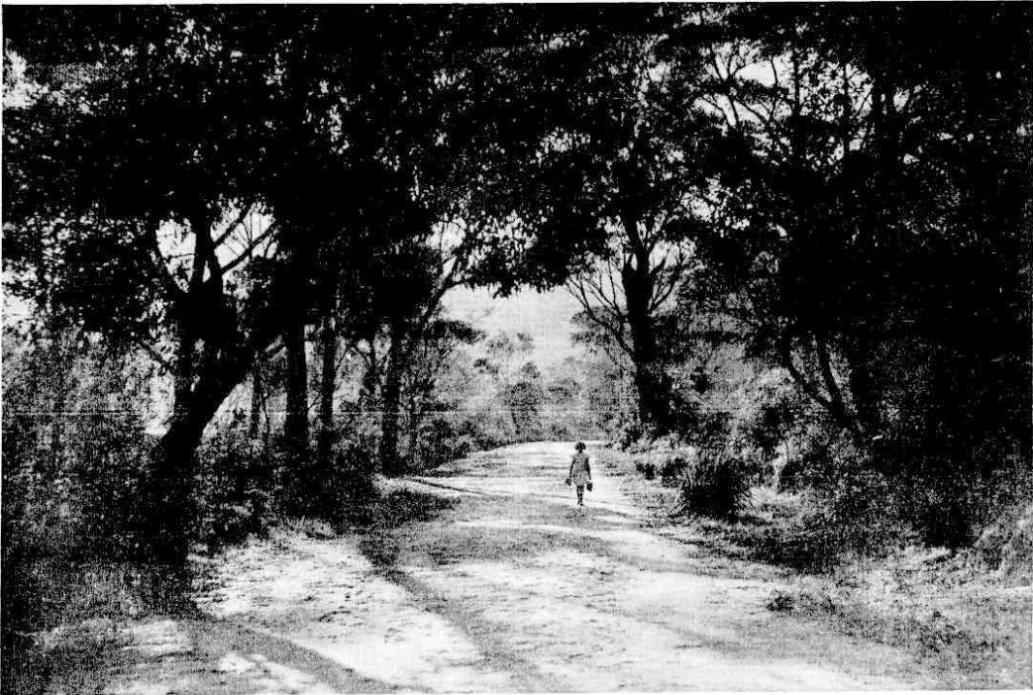
LATE AFTERNOON STUDY IN DEEP CREEK-ROAD, NARRABEEN. Woodland Shades-- (1935, October 30).The Sydney Morning Herald (NSW : 1842 - 1954), , p. 16. Retrieved from http://nla.gov.au/nla.news-article17237516
NARRABEEN
BENEATH a clouded sky of pearl and snow,
Where soft robes hide the sunset's rosy hands,
The white gulls breast the wind, and far below,
White horses ride the breakers to the sands.
Beyond the clear green waves of Narrabeen,
The dim, long headlands, lying in the arc.
Grey with the evening hawks, keep, serene,
Their watch above the ocean's majesty.
— KITTY BARNES.
NARRABEEN (1926, January 30). Evening News (Sydney, NSW : 1869 - 1931), p. 4. Retrieved from http://nla.gov.au/nla.news-article126135763
Prior to the June storm of 2016 we had begun gathering many of the pictures we’d found so far in old news items or stashed away in interstate libraries to showcase these as a celebration of this wonderful place.
When the storm occurred, the focus changed and the celebration was put back. Continuity on these storm events, as per Natures cycles, was more vital for those people who suffered through this latest event and for the records to show some of what had happened there in the same seasons, annually, for as long as structures had been placed in the path of such storms and their flows through the landscape.
Two recent items reminded this celebration should occur – the first a small snippet of a Manly film company using the Narrabeen area to film some of Australia’s earliest silent biographies through the Australian Life Biograph Company, run by one Gaston Mervale who shot most of the interiors in a factory in Manly from 1911 to 1912, and the above wonderfully whimsical image of a girl walking down a glorious Narrabeen avenue on a sunny day.
How could anyone not fall in love with this place every time they get to set a foot in that surrounds?, even without such images to capture the living visions there.
Realism for Picture Shows.
RESIDENTS of Narrabeen and the Pittwater district are enjoying the exciting spectacle in their midst of stuck up mail coaches, galloping bushrangers, and troopers, beauteous heroines on horseback, and other paraphernalia of the good old bushranging days of New South Wales, while the hills around are resounding with the rifle and revolver shots of outlaws and police engaged in mortal combat on the roads, and in the neighboring bush. Alas, it is all make- believe. It is nothing more than the operations of the Australian Biograph Company, who are out on an expedition for film-making, and they have selected this beautiful and picturesque territory as a background for their pictures of Australian life and incident. - A strong cast of leading actors and actresses are engaged in the strenuous work, including Miss Harrie Ireland, Mrs. and Miss Herbert, Messrs. Gaston Mervale, Godfrey Cass, and other well-known artists. Over 40 horses are employed in the operations, which are on an extensive scale., Mr. Clarke is in charge of the camera. The company will work in the district for a week. Out in French's Forest, in the vicinity of the Oxford Falls, the Spencer Biograph Company are also engaged in the same class of task. Realism for Picture Shows. (1911, February 1). Balonne Beacon (St. George, Qld. : 1909 - 1954), p. 4. Retrieved from http://nla.gov.au/nla.news-article215387874
The Friends of Narrabeen Lagoon Catchment have a whole program of events set for their Narrabeen Spring Celebration
From their website: "Our catchment comes alive! There are dozens of events you can get involved in … right on your doorstep… most of them free!"
There is also an upcoming Jim Somerville Bridge Ceremony, a tribute to a gentleman who did so much to ensure Narrabeen Lagoon and its surrounds remained recognisable.
To get you in the mood to revel in all things Narrabeen we now run some of these glorious pictures and a few items that are signposts of sorts for Narrabeen, so if and when you venture into or around Narrabeen Lagoon this Spring, Summer or next Autumn and Winter you have some comparisons …so you can see how much each place has changed, or, how much they are still the same.
Narrabeen attracted visitors as soon as some kind of track was established. It was the upgrading of this road and a the Narrabeen Bridge being built, with tenders only called for late in 1882, that really began to, as many put it in many articles 'open the area up' for visitors. The bridge building e[isode seemed to go on for at least a year once funding was finally committed to this:
Ministers replied to questions respecting the Public school teachers at Pokolbin, the want of a bridge over Narrabeen Lagoon, FRIDAY, SEPTEMBER 8. (1882, September 12). Queanbeyan Age (NSW : 1867 - 1904), p. 2. Retrieved from http://nla.gov.au/nla.news-article30679105
Mr LACKEY in answer to Mr Teece, said that tenders for a bridge over Narrabeen Lagoon, close to the present road, would be invited in two weeks… PARLIAMENT OF NEW SOUTH WALES. (1882, September 9). The Sydney Morning Herald (NSW : 1842 - 1954), p. 9. Retrieved fromhttp://nla.gov.au/nla.news-article13526176
Several weeks later...
TENDERS FOR PUBLIC WORKS AND SUPPLIES. TENDERS are invited for the following Public Works and Supplies…
Wooden Bridges on Iron Piers, and Approaches, Narrabeen Lagoon, Road Manly to Pittwater
Closes 11 o’clock, 21st November. Advertising (1882, November 15). Evening News (Sydney, NSW : 1869 - 1931), p. 8. Retrieved fromhttp://nla.gov.au/nla.news-article107997505
Land offered for sale around the same time:
NARRABEEN.-Capital subdivision block, comprising 100 acres of well timbered land, adjoining the residence of John Wheeler, Esq. ; a chance seldom met with.
NARRABEEN LAKES" NARRABEEN LAKES.
Splendid Blocks of Land, water frontages, great depths. Price, only £10 per block, on the following terms:-£2 cash deposit, balance in 3 and 4 months, without interest; or a discount of 10 per cent, allowed for cash. CHAPMAN and LAMB, Estate Agents, 331. George-street. Near Wynyard-street. Advertising (1882, December 16). The Sydney Morning Herald (NSW : 1842 - 1954), p. 4. Retrieved from http://nla.gov.au/nla.news-article28378243
Those north of the still not complete bridge point out the general disarray of the track leading into Pittwater proper and a few other needs:
DEPUTATIONS. THE NARRABEEN-ROAD.
A deputation, consisting of the Mayor or St Leonards, Dr Tibbit's, and several other gentlemen, waited upon the Hon. Alexander Stuart, Colonial Secretary, yesterday, to request that the Narrabeen-road from Manly to Pittwater be put in a proper state of repair, and that a jetty be constructed on Church Point at Bayview, Newport. The road, it was represented, was now in a very bad condition, and if it were put into proper order it would open up one of the most beautiful districts in the colony. The jetty was required tor the benefit of children going to school and people in attending church. The deputation also asked for a bathing place.
Mr. Stuart said ha was quite aware that the road had been in a very bad condition, but it was gradually, perhaps rather too slowly being made, andas soon as a bridge was carried across Narrabeen the work on the other side must follow in a matter of course. He would give instructions to have the road examine specially, and reported, upon to him, during the ensuing week, and he would take an opportunity in visiting the locality and seeing what further could be done in the way of relief. With regard to the jetty he would give the matter consideration but while the Government might erect a wharf he thought the inhabitants ought to construct a bathing place. The next thing likely to be wanted by the residents could be that the Government should go and wash them. DEPUTATIONS. THE NARRABEEN-ROAD. (1883, June 2). The Sydney Morning Herald (NSW : 1842 - 1954), p. 9. Retrieved from http://nla.gov.au/nla.news-article13536041
While Narrabeen was clearly a place for timber-getters - men like Leon Houreaux, who was was in Narrabeen and Ingleside doing this work
TIMBER HEWERS AND SAWYERS Wanted, to get Timber for bridges, Narrabeen; timber found. Particulars apply on the work; or to Walton Pell, contractor, Denison-street, Woollahra. Advertising (1883, February 28). The Sydney Morning Herald (NSW : 1842 - 1954), p. 16. Retrieved from http://nla.gov.au/nla.news-article28375105
The area, apart from being farming land, was also a boon for fisherfolk and in 1884, the beginning of the Ingleside Powder Works - which turned out to be a bit of con job:
OYSTER BEDS.-The undermentioned oyster bearing waters have been proclaimed open for dredging : -Brow Lake, Camden Haven, Candlegut Creek, Congo Croek, Hunter River, Jervis Bay and tributaries, Lake Macquarie, Manning River (beds only), Narrabeen Lagoon, ..Government Gazette. (1883, July 28).Australian Town and Country Journal (Sydney, NSW : 1870 - 1907), p. 39. Retrieved fromhttp://nla.gov.au/nla.news-article71001949
For more see: Narrabeen Prawning Times - A Seasonal Tide of Returnings and Oystering in the Pittwater Estuary - Oyster Kings and Pearl Kings and When Not to Harvest Oysters or Yabbying In Warriewood Creeks or Eeling in Warriewood's Creeks (Includes A Short History of community involvement in environmental issues/ campaigns in and around Narrabeen Lagoon - 1974 to present by David James OAM)
An important industry is about to be established at Narrabeen, New South Wales, where the necessary structures are being erected for the manufacture of gunpowder and blasting powder of various kinds. Tho proprietor of the works is Mr. C. Van Buren, formerly proprietor of large powder mills in Pennsylvania, who has secured a site exceedingly well adapted for powder mills, and at the same time at a sufficient distance from population, and so isolated, as to leave no room for apprehensions of danger in the event of an explosion taking place. It is expected that the works will be sufficiently advanced in about six weeks' time to enable the proprietor to commence the manufacture of black powder. NEWS OF TEE DAY. (1884, March 8). The Age (Melbourne, Vic. : 1854 - 1954), p. 9. Retrieved from http://nla.gov.au/nla.news-article198558463
For more see - Ingleside Powder Mill - Pittwater Fields of Dreams
NARRABEEN.
The new bridge at Jenkins' Creek is to be commenced. The approaches on either side of this creek are in a fearful state. As there has been such an enormous increase of traffic on this road, the authorities should allow a special grant to have the road properly made. The amount allowed per mile would then be sufficient to keep same in repair. It is hoped that the promise made by the Commissioner of Roads, viz., to have a railing put upon the approaches to Narrabeen bridge will be fulfilled. The Hon. W. B. Dalley was on one occasion capsized into the lake. This district is looking beautiful; the rock lilies and wild flowers are commencing to bud, and flowers in great profusion will be displayed in full bloom by the end of August. Gillbirds have not been at all plentiful this season. Hundreds of disappointed shootists have had to return home without a brace. Many have taken revenge by shooting a few magpies or a stray parrot. NARRABEEN. (1887, July 29). Evening News (Sydney, NSW : 1869 - 1931), p. 5. Retrieved from http://nla.gov.au/nla.news-article108007815
The unfortunately hunted Gill birds are what we now call Red Wattlebirds - the 'gill' would refer to the red gill these birds have on their neck - this is also where their name 'wattlebird' stems from, not from a predilection for wattle trees as may be supposed. They were hunted for their meat and became quite scarce. They also, now, are quite wary of human beings - clearly for good reason.
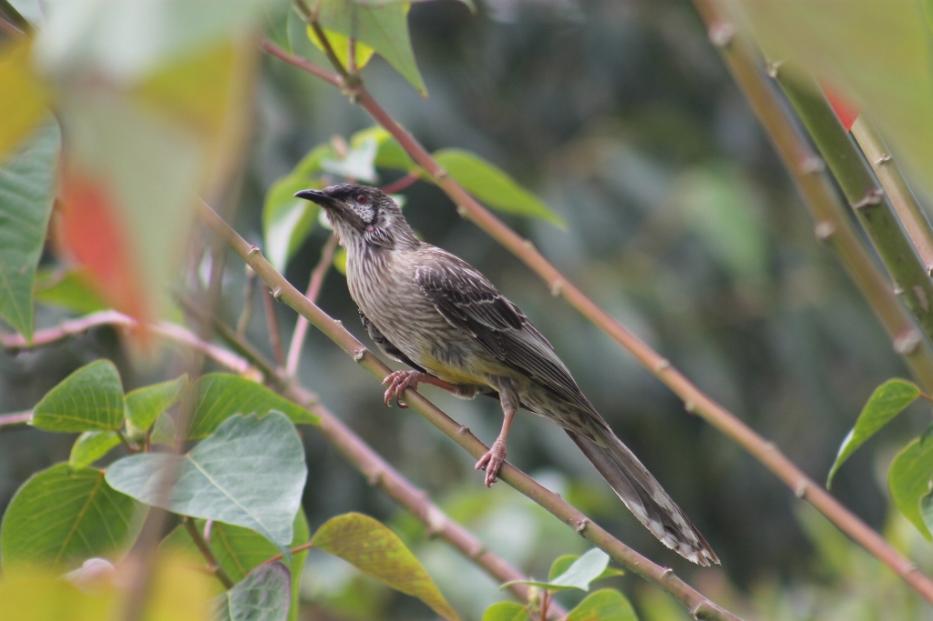
Red Wattlebird - Avalon - A J Guesdon picture, 2012
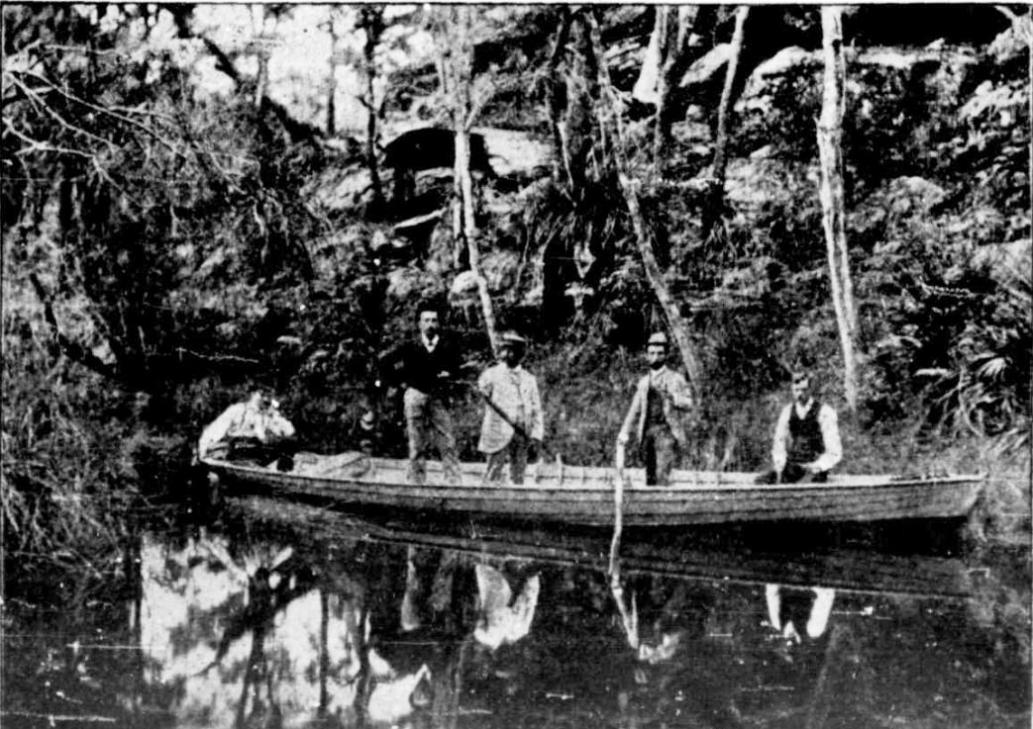
On the Narrabeen Lagoon, AT MANLY.
The picture, shown on this page, is taken at one of the most picturesque spots on the lagoon. It is on the opposite side from Manly, close to the gasworks; though it is sacrilege to name the lagoon and gasworks in the same breath. The party in the boat wended their way pleasurably up one of the many pretty tributaries. The picturesquely-wooded foreshores, with their fretted rocky caves and mirror-like waters, form a surpassingly beautiful scene. Ferns, flowers, and grasses are plentiful. Shady nooks and bathing places easily found. The picture is quite an artistic creation, and does not belie the original. Regular bodily, exercise is worth a host of physicians. On the Narrabeen Lagoon-Manly. (See letterpress on this page.) On the Narrabeen Lagoon, (1892, March 19). Australian Town and Country Journal (Sydney, NSW : 1870 - 1907), , p. 30. Retrieved fromhttp://nla.gov.au/nla.news-article71235518
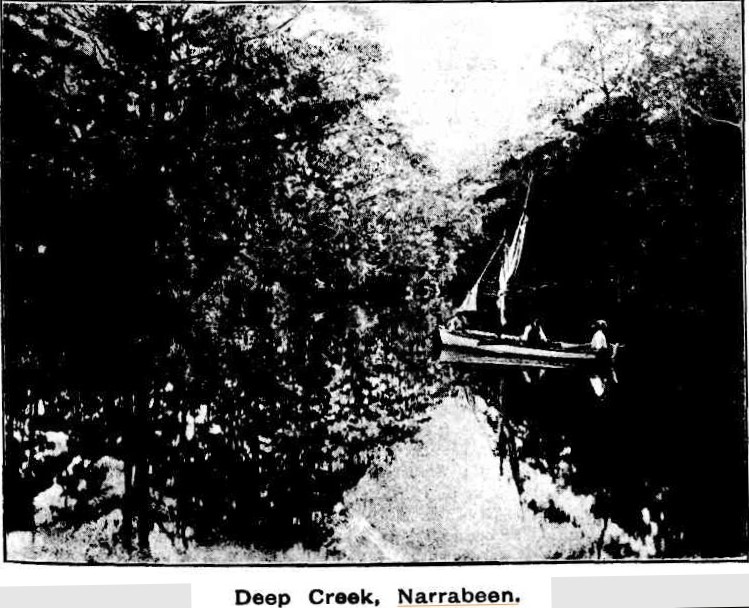
Above: Deep Creek, Narrabeen. Contemporary Journalism. (1893, November 25). Illustrated Sydney News (NSW : 1881 - 1894), p. 15. Retrieved from http://nla.gov.au/nla.news-article63672414 Below:Narrabeen Lakes, No.a116487, courtesy State Library of NSW
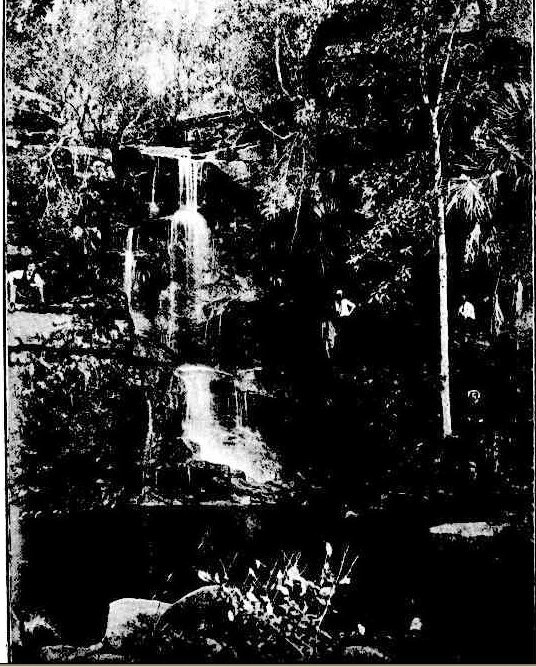 Right: Narrabeen Falls. A Christmas Holiday Trip. (1893, November 25). Illustrated Sydney News (NSW : 1881 - 1894), p. 14. Retrieved from http://nla.gov.au/nla.news-article63104125
Right: Narrabeen Falls. A Christmas Holiday Trip. (1893, November 25). Illustrated Sydney News (NSW : 1881 - 1894), p. 14. Retrieved from http://nla.gov.au/nla.news-article63104125NARRABEEN
We are just back from Narrabeen, after such a delightful week. We have been cycling, boating, swimming, fishing and picnicking. Really, Narrabeen is the most charming place I know, so easy to get at, and so cheap. What do you think it cost us for the trip ? — only 10s each, and what a lot we got for our money. I will give you all the details of our expenditure. First of course came the boat fare to Manly (6d). Arrived at Manly, the party divided, half patronising the coach, which takes you down to Narrabeen for a shilling, and the other more fortunate half mounting our bicycles to enjoy the eight-mile spin over a capital road which lay between us and our destination. We had engaged the largest cottage to be had in the place, as our party was a large one, numbering some ten or twelve. It cost us £2, but I think it was well worth the money, as there was ample accommodation for us all, and everything that we could possibly want was provided, with the exception of knives and forks and house linen, which we brought with us. It was also most conveniently near the little store, where we bought all our provisions and ran up a bill for milk, bread, potatoes, groceries, &c., which amounted to some 30s when settling day arrived. From the store we also engaged a boat for the week, which cost us 10s. Perhaps you don't know that there is a very pretty lake at Narrabeen? To be sure it is not very deep, and we occasionally got stranded on sand banks at first, but the boys were always quite ready to get out and push us off, and we soon learnt to know the channels so well that their assistance in that line was no longer necessary. There is much deeper water in the three creeks which empty themselves into the lagoon, and if you want to bathe I advise you to choose the middle of the three, which is about 5ft deep, and has a delightfully sandy bottom. We also "spreckled by moonlight" on the ocean beach (if you don't know what that means ask a Scotchman), and enjoyed a ride to Newport on our bicycles, with a halt at Rock Lily for refreshments. — Cousin Kate. NARRABEEN. (1897, December 26).Sunday Times (Sydney, NSW : 1895 - 1930), p. 4. Retrieved from http://nla.gov.au/nla.news-article126247931
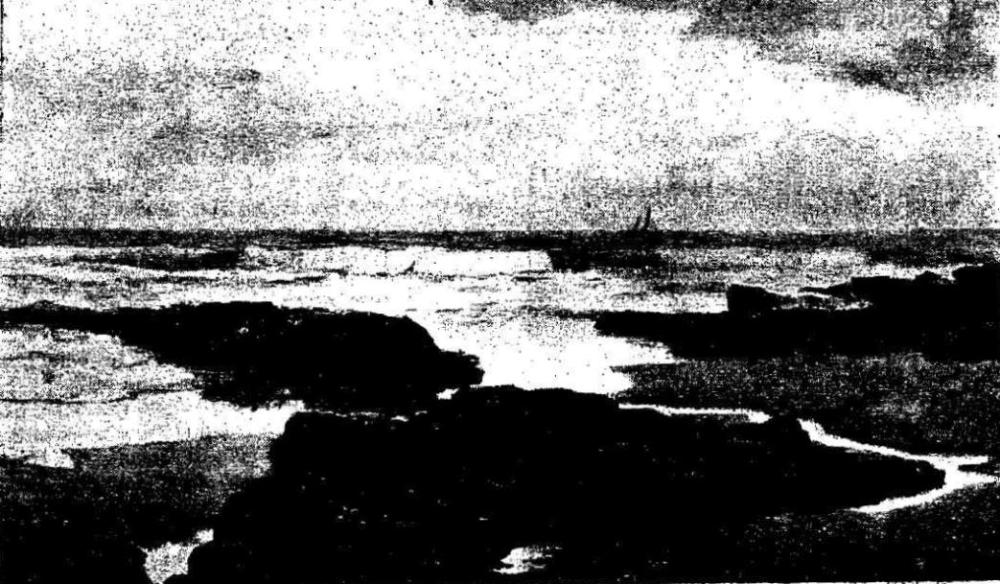
'THE COAST AT NARRABEEN.'— Albert J, Hanson. Art Society. THE ART EXHIBITIONS. (1899, August 26).The Sydney Mail and New South Wales Advertiser (NSW : 1871 - 1912), , p. 504. Retrieved from http://nla.gov.au/nla.news-article163688446
A case of putting some trees back just twenty years after the timber-getters had cleared so many away:
NARRABEEN.
Some time ago a number of trees were planted in the school grounds at Narrabeen with the view of beautifying, and at the same time affording shelter to the site. Unfortunately the late drought, following on before the trees were well established, caused them to die. Mr. McDonald, late of the Cowper district, set about refilling the vacancies, and on Saturday afternoon, the 22nd ult., Arbor Day took place. A large number of residents and visitors turned out, and a very enjoyable time was spent. Aid. T. J. West presided over the gathering, and congratulated Mr. McDonald on the splendid report given by the Chief Inspector at the recent inspection of work under the new Syllabus. Speeches were also delivered by the Mayor of Manly and Mr. Powell (See Local School Board). The planting or the trees by representatives of all the families around, then took place amongst the hearty cheers of scholars and friends after which ample justice was done to the good things provided by the ladies. Regret was expressed that Mrs. McDonald was absent, owing to sickness of one of the family. NARRABEEN. (1905, August 1). Clarence and Richmond Examiner (Grafton, NSW : 1889 - 1915), p. 8. Retrieved from http://nla.gov.au/nla.news-article61422558
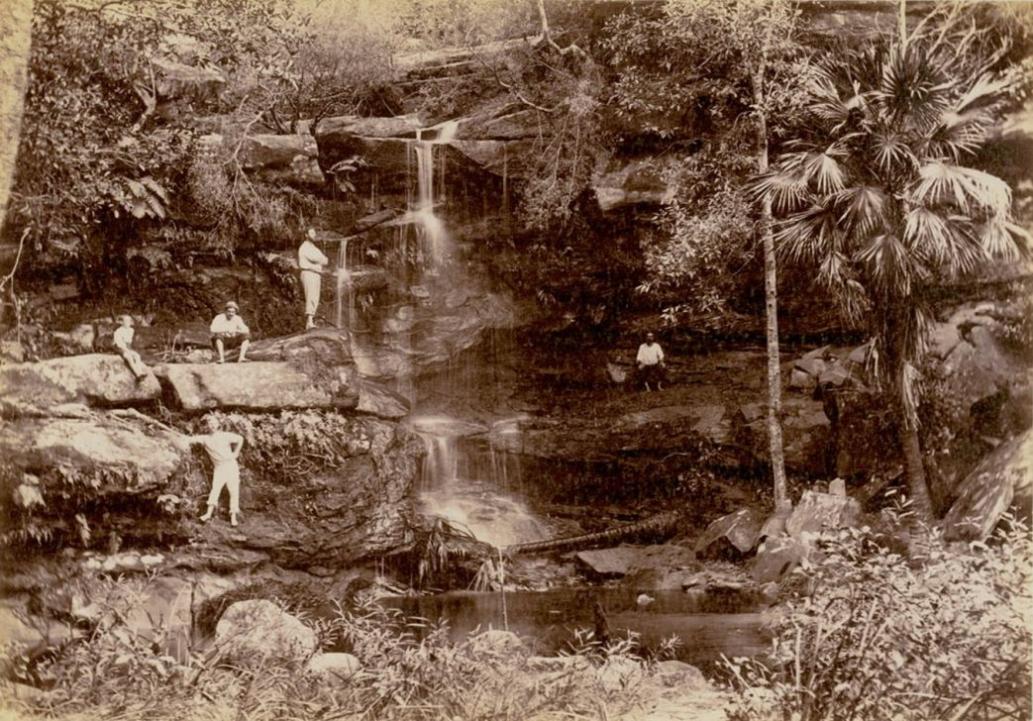
Falls - Narrabeen Lakes, ca. 1900-1910, Image No.: a116484, from the collections of the State Library of NSW.
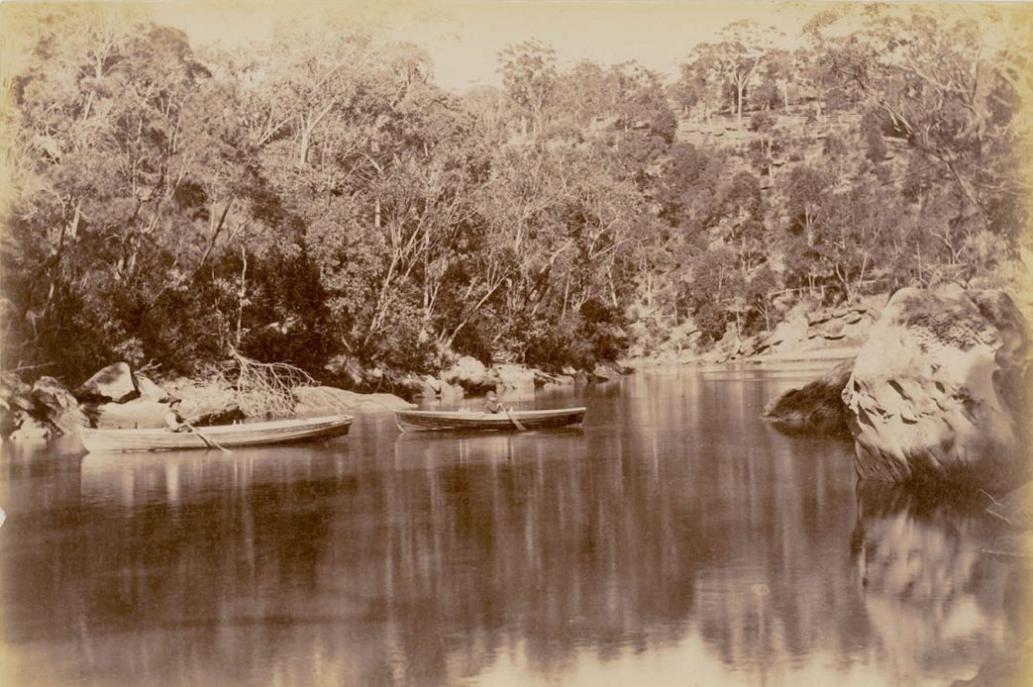
Above and below 'View - Narrabeen Lakes', ca. 1900-1910, Images No.: a116485, a116486, a116487, a116488h and a116489 from the collections of the State Library of NSW.
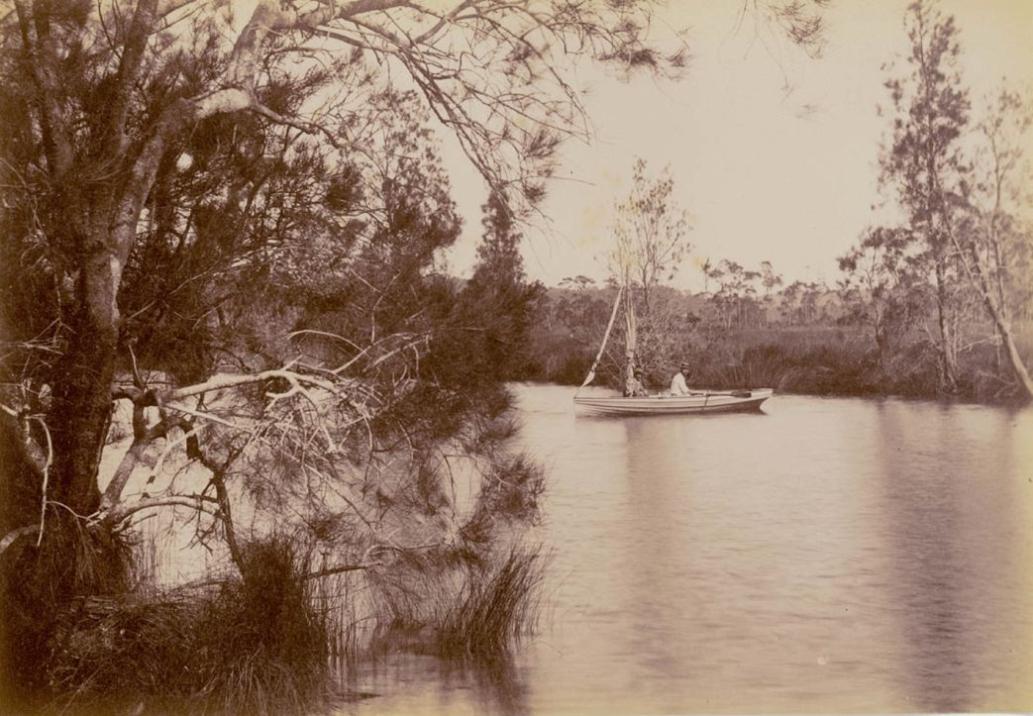
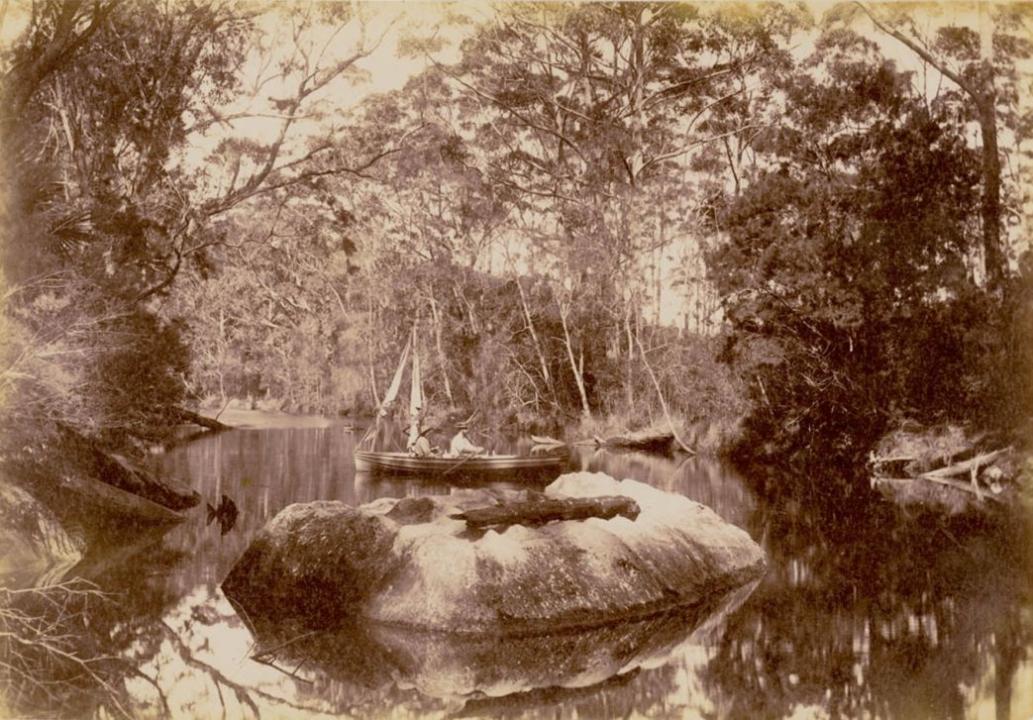
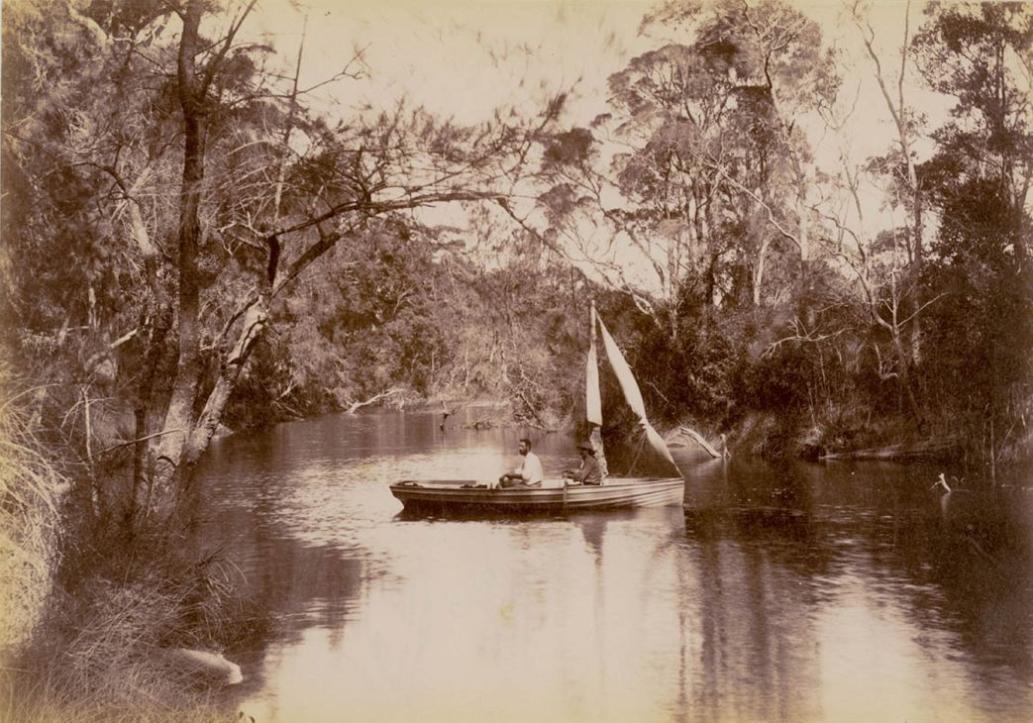
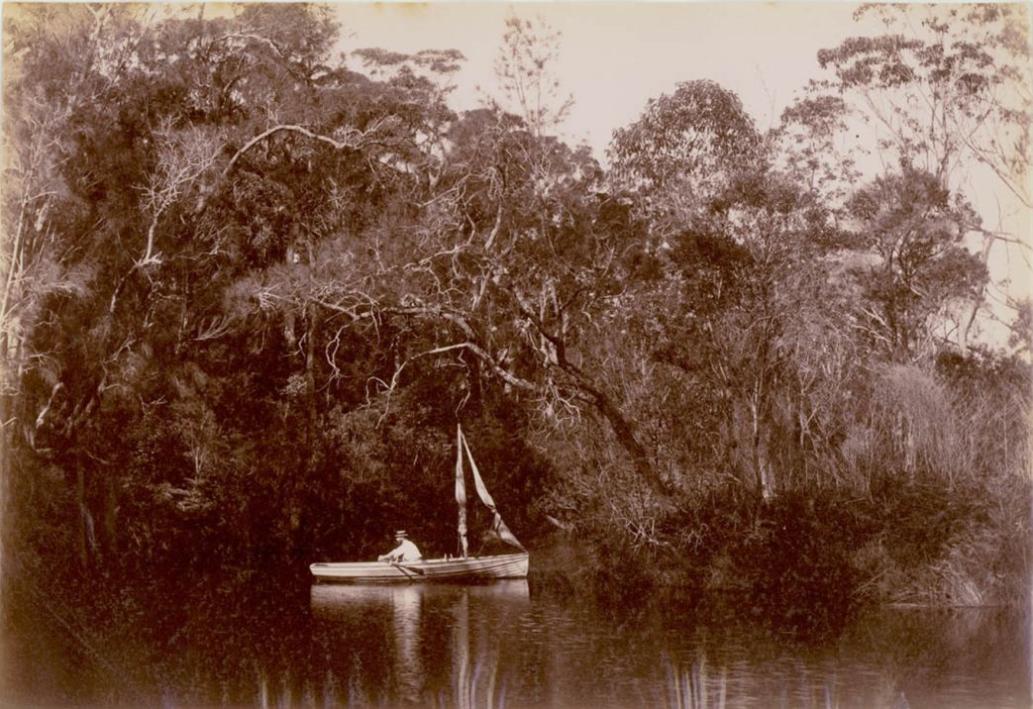
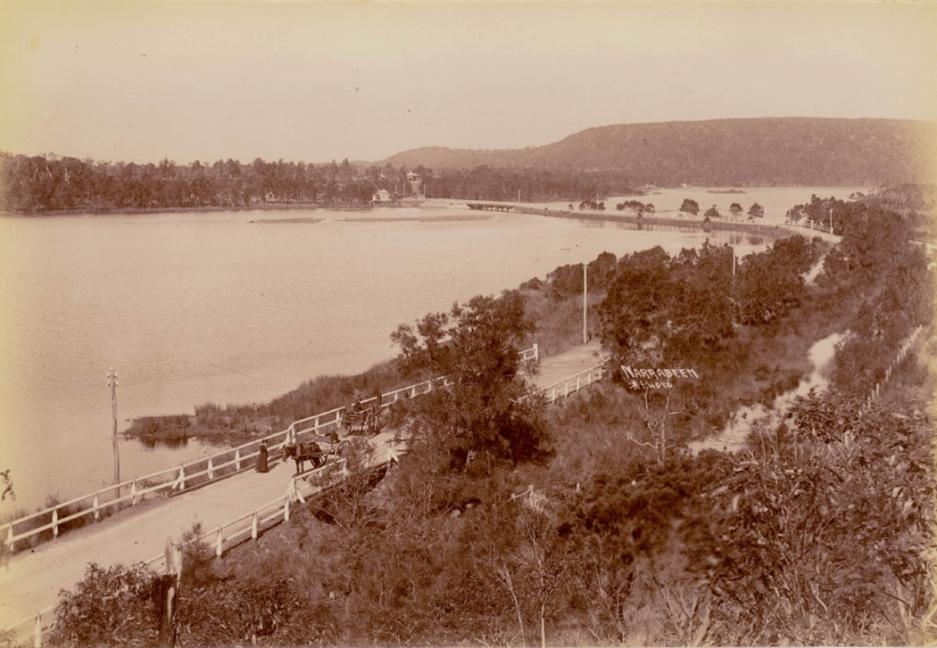
View - Narrabeen Lakes, ca. 1900-1910, Image No.:a116483 courtesy State Library of NSW.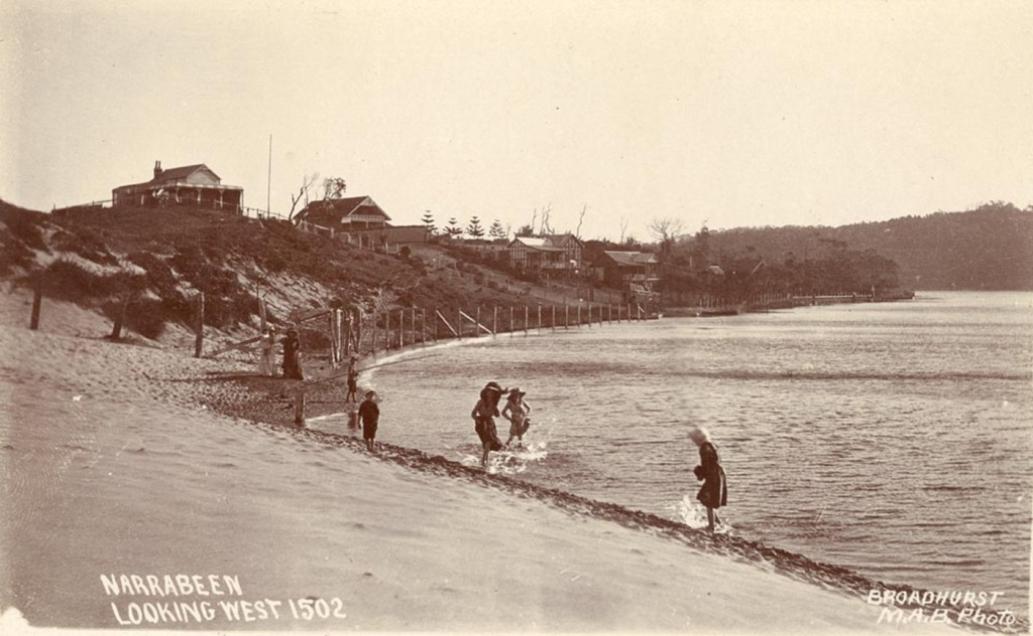
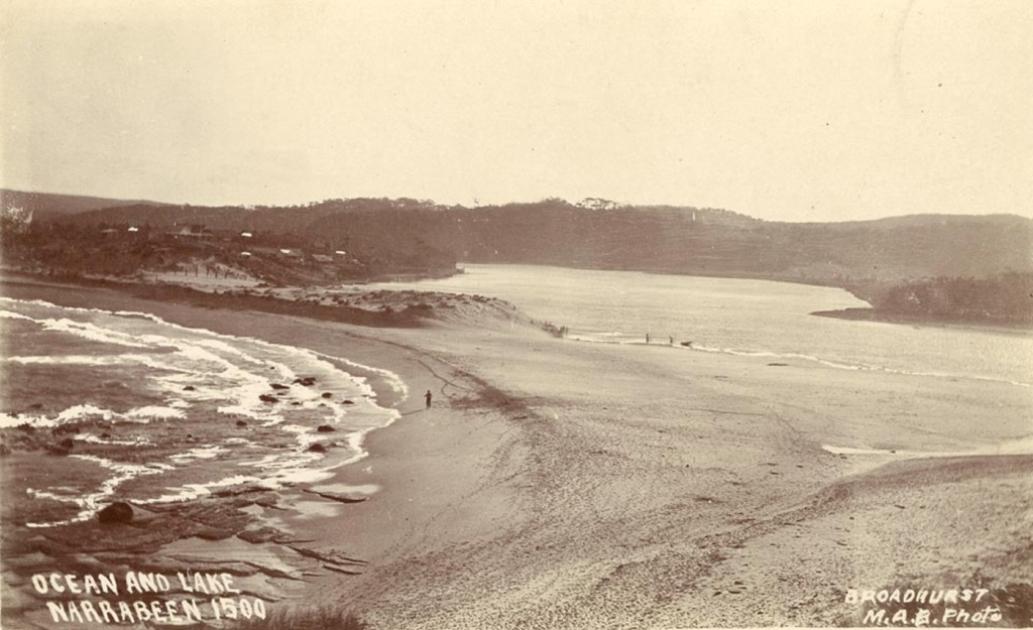

From Scenes of Narrabeen album, ca. 1900-1927- Sydney & Ashfield : Broadhurst Post Card, courtesy State Library of NSW. Images No: a106056h (above) and a105060h Courtesy The Mitchell Library, State Library of Australia

As can be seen above, Narrabeen did not have a permanent opening for flood waters to rush out to sea - this occurred as an overspill. When sand had built up too much for this to occur a channel had to be dug. This eventually became a permanent and ongoing requirement.
ANGLING.
NARRABEEN LAKE.
At the Amateur Fisherman's Association on Thursday night Mr. W. Dorman gave the members a graphic account of the opening of Narrabeen Lake to the sea. Four hours' work with shovels cleared a channel for the water, and the rush of lake water speedily spread over two chains. Many people secured fish with hands and nets, and a net fisherman brought along a net to secure them, but was afraid to use it for fear of making a breach of the Fisheries Act. Most of the fish appeared to be unwilling to leave the lake, and fought against the rush of water, but the mullet were quite nonplussed, and many magnificent fish were swept out to fall victims to their natural enemies in the ocean. The waste of fish was tremendous, although the night was interesting from a natural history point of view. Mr. E. N. Atkin also referred to the wonderful instinct of rapacious ocean fish which assembled out- side the channel, and even stranded themselves on the ocean beach in their eagerness to get at their bewildered prey. The mullet and other fish were of fine size, and in splendid condition. No flathead or garfish were noted going out. A catch of schnapper weighing 17½lb cleaned was reported, at the same meeting as having been obtained by Mr G. Williamson at Middle Harbour. ANGLILNG. (1910, March 19). The Sydney Morning Herald (NSW : 1842 - 1954), p. 11. Retrieved from http://nla.gov.au/nla.news-article15151735
Opening the lagoon to the sea permanently:
TO OPEN NARRABEEN LAKE.
Mr. Griffith, Minister for Works visited Narrabeen on Wednesday afternoon for the purpose of inspecting the Narrabeen Lake and considering the best means of providing a permanent opening at the mouth of the lake. President Quirk and the shire councillors welcomed the Minister, who was accompanied by Dr. Arthur, M.L.A. and Mr. Wheedon, engineer from the Public Works Department. The Minister and party were rowed over the lake, and then proceeded in motor cars to the lagoon opening. An adjournment was afterwards made to the picnic grounds near the bridge, where refreshments were partaken of and speeches delivered. Councillor Quirk presided, and appealed to the Minister to give the shire people some assurance that the work of draining the lagoon and constructing the tram to the district would be proceeded with. The Minister, in reply, said that a survey would be made, and arrangements entered into with the shire for the object of having the work carried out. A great deal depended on the successful draining of the lagoon. His ambition was to make the lake the most attractive boating place in the Commonwealth. Sydney's thousands who live in crowded dwellings should be given an opportunity of enjoying Nature's blessings, and he intended, with the assistance of the Government, to give them access to those spots. Dr. Arthur, ML.A., also addressed the gathering. TO OPEN NARRABEEN LAKE. (1911, February 2). Evening News (Sydney, NSW : 1869 - 1931), p. 10. Retrieved from http://nla.gov.au/nla.news-article113941211
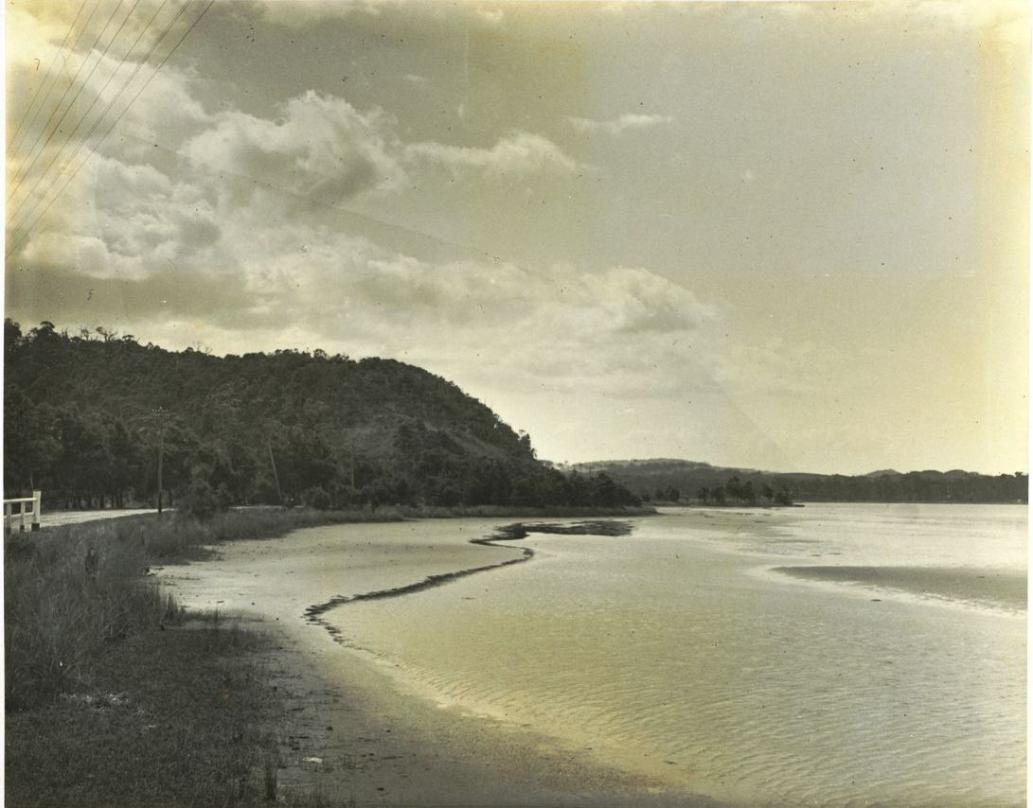
'View taken near Narrabeen on the road to La Corniche' - Sunday September 17th, 1911. Image No.: a3289060h from Allen family albums, courtesy State Library of NSW
Saturday December 13th, 1913 – the tram line is officially opened and access to Narrabeen Lagoon becomes easier and faster and people poured into the area - perhaps a little like rain-waters pour into the lagoon and then the ocean through all the creeks that lead to Narrabeen lagoon to run out into Narrabeen Beach:
NARRABEEN TRAM. OPENED TO BRIDGE. A PICTURESQUE DISTRICT.
The extension of the tramway from Collaroy Beach to Narrabeen Bridge was on Saturday afternoon the subject of great local festivities.
A special tram, gaily bedecked with Christmas bush, waratahs, and palms, conveyed a large party from Manly Beach wharf to the bridge, a distance of about eight miles. The journey lies through remarkably pretty scenery, which will most likely make the run a favourite one with excursionists. During the whole distance the traveller is with-in hail of the beaches, upon which the waves of the Pacific Ocean beat, and the many glimpses of blue sea, with snow-white embroidery, as the rollers wash into spray on the shingle, and the glimmering stretches of sand, serve to make the trip a delightful one. Deewhy Lake, with its black swans, is passed en route, and the tram brings one to the first of the Narrabeen Lakes.
It was explained by Mr. Quirk, in opening 'the proceedings, that the Minister for Works (Mr. Griffith) had built the tramway to Collaroy Beach, which was as far as he could take it, for less than £20,000. The mile section from Collaroy to Narrabeen was an addition.
The ceremony of cutting the blue ribbon across the track and declaring the extension open was carried out by Mrs. Griffith, the wife of the Minister, who said they were very pleased to have with them Mrs. B. W. O'Sullivan, widow of the Minister for Works who had turned the first sod in connection with the tramway. (Applause.)
A party of visitors were then driven round the district in motors as the guests of the Pittwater Progress Association, the excursion showing that the neighbourhood is progressing. The Narrabeen Lakes country together with that intervening between it land the "village," constitutes Manly's big "back yard," as it has been called. Judging by some of the vegetable and fruit gardens seen between Manly and Narrabeen, the country is by no means unsuitable for agriculture. After Mrs. Griffith had cut the blue ribbon, the local children rendered "Advance Australia Fair."
Mrs. Griffith was presented with a diamond ring as a memento of the occasion.
At the conclusion of the ceremony a Venetian carnival was held on the Narrabeen Lakes. NARRABEEN TRAM. (1913, December 15 - Monday).The Sydney Morning Herald (NSW : 1842 - 1954), p. 10. Retrieved from http://nla.gov.au/nla.news-article15497971
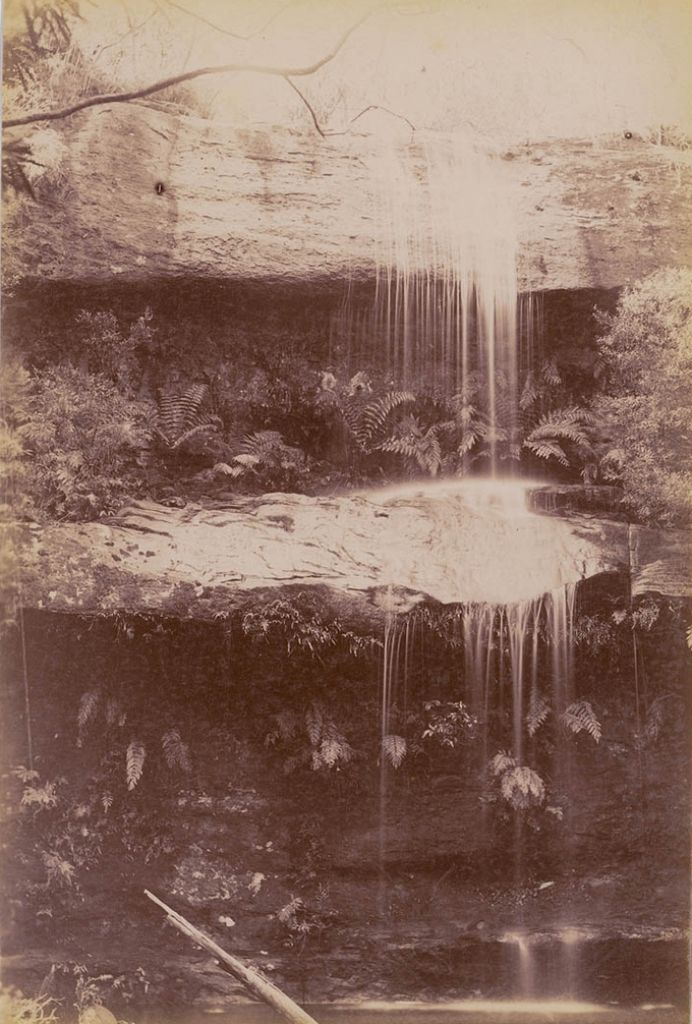
Falls - Narrabeen Lakes Circa 1900-1910, Image No.: a116522, courtesy State Library of NSW
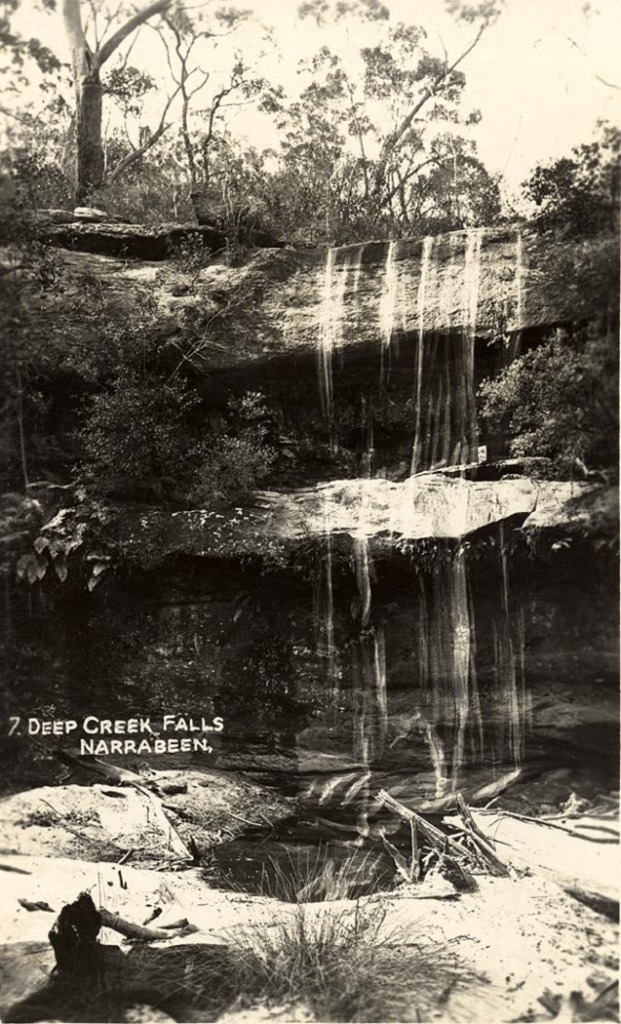
Deep Creek Falls, Narrabeen. Image No.: a106061h from 'Scenes of Narrabeen' ca. 1900-1927- Sydney & Ashfield : Broadhurst Post Card, courtesy State Library of NSW
NARRABEEN WATERFALLS.
By W. F. MACLEAN.
THE watersheds of the coastal lagoons at Manly, Curl Curl, Deewhy, and Narrabeen are, in the main, rolling uplands, interspersed with deep sheltered gullies densely clothed in underscrub, in some places literally impassable for the tangle of vine and undergrowth. Each gully is traversed by a creek, a veritable babbling brook of the poets, smaller or larger according to the area it drains. The descent is usually steep. Nearly every creek has waterfalls, which vary in height, from a few feet to twenty or thirty, flowing through soil composed of silt from the higher lands and the decaying debris of the bush, gum leaves, and rotten wood, which with sand from the erosion of the rocks makes up a compost of the highest degree of fertility. Common bracken grows in these places to the height of a man, and boronia (binnata) to the same size. The coachwood, a cousin to Christmas bush, may also be seen at its best; the flowers are somewhat similar to those of the latter, but larger, and the petals are wider separated. The foliage is also much larger, making a beautiful shade tree. It does not thrive away from its damp gullies; otherwise it would be seen more in suburban gardens.
NARRABEEN, the largest lagoon in the Warringah shire, drains the most extensive area. Substantial creeks flow into it, the drainage of many square miles — South Creek, Middle Creek. Deep Creek, and others. There are waterfalls on tributaries of several of these creeks. The falls illustrated are easily accessible to pedestrians and vehicles, including motors.
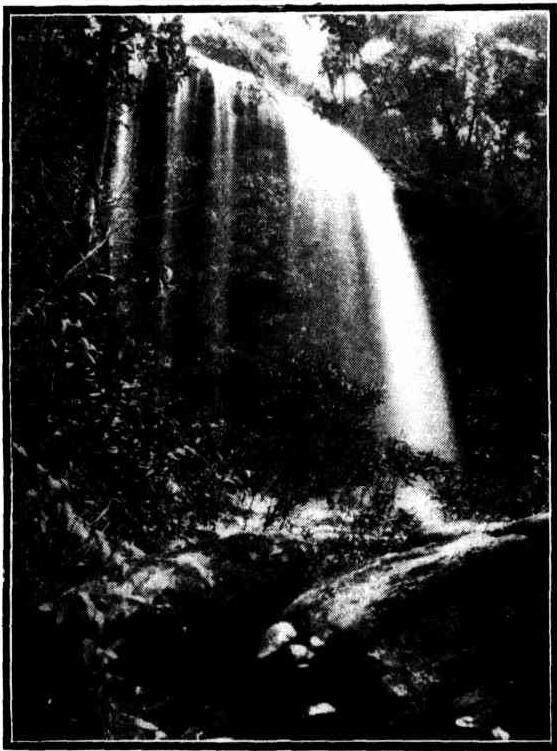
THE UPPER NARRABEEN FALLS.
To secure the photographs we left the tram at Narrabeen terminus, crossed the lake by bridge, and walked along the causeway to the big headland which ends at the road just on the other side of the lake. Rounding the spur the road stretches straight into the west. On one side is an arm of the lake, into which Powderworks Creek runs; the other side is hilly and well covered with week-end cottages. The road is of red Boil, with deep cart-ruts, which were filled with water from recent rains. There is a slight but nippy wind from the south-west, which makes walking a pleasure. On past two gum trees of large diameter, one on either side of the road, their branches intermingling overhead, and up a slight rise to where a road branches off to the left. We ignore this turn-off and descend a slight hill with a small cottage 'at the bottom, on to the right, and over a little culvert. Three minutes through a rough piece of road, a swamp to the right very densely overgrown with all kinds of small scrubs — amongst which large swamp mahogany trees rear themselves above the smaller stuff — and we arrive at the road's end. Immediately in front of us is a large pool about 100ft x 50ft, backed by a waterfall. This fill is rather disappointing, in itself; but the surroundings are beautiful. A few years ago a large mahogany tree sloped across the pool at such an angle that it. was easily . walked upon to its utmost branches. There were also a number of giant cabbage-tree palms, perhaps 100 feet high. To-day only one remains; tbe others have, fallen to some wanton axe. The stockwhip bird is found here in great, numbers, its note being heard continually. The conditions are very favourable for these birds' breeding-place.
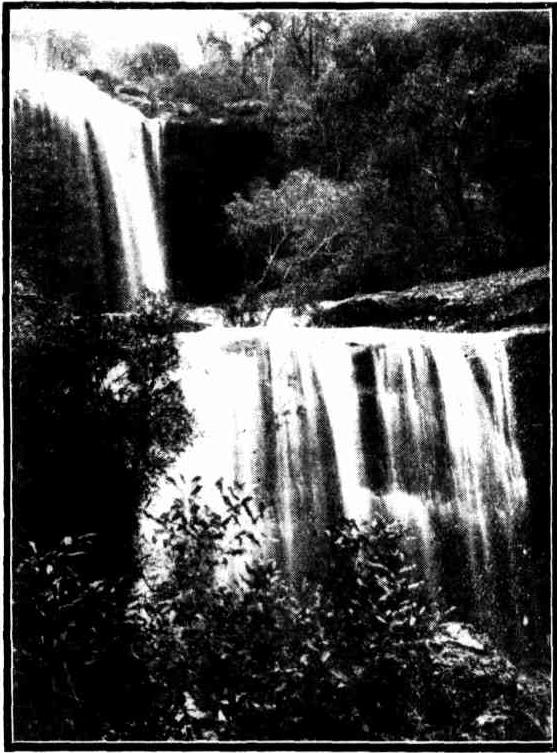
THE UPPER AND LOWER NARRABEEN FALLS.
APPARENTLY this is about as far as you can go, the cliffs being rather precipitous; but to the left of the falls is a medium-sized palm, and underneath this is a faint track up the hillside. Climbing this and descending slightly, we reach the rocky bed of the creek. The soil has long since been washed away, leaving the naked rock, over which, the water runs noisily. There are many pools filled with beautiful drinking-water, and in the ? larger yabbies (small crayfish) of a greenish hue can be seen if one sits still enough. The sides are covered with umbrella fern, and tall plants of boronia with flowers just past their prime lift their heads above the ferns. The bed of the creek soon becomes too rough, and compels us to go further up the hillside, which is very steep and clothed with great red gums, turpentines, bloodwoods, and oaks. The ground is covered ankle-deep with oak needles, and in some places is almost impassable with the top hamper of large oaks that have been felled for shingles. The pale pink of boronia past its prime, the paler pink of a sister variety just coming into bloom, the purple hardenbergia and yellow dillwynia all combine with the many shades of green and the russet brown of dead leaves and bracken to make a lovely combination of colour. Above the noise of running water gurgling and babbling, and the noise of a waterfall somewhere in the near distance, sounds the song of birds— the sharp, penetrating crack of the stockwhip, followed by the 'weet-weet' of its mate, and the equally penetrating and beautifully full note of the grey thrush. A yellow robin — silent now, although later on, when dusk creeps over the gully, its note will predominate —perches motionless on the bark of a dead tree, watching ?with large eye our every move. You can be sure its nest is close by, but so well hidden with Nature's camouflage that you need to look closely to find it. We could sit for hours enjoying the scene before us. There is constantly something to interest. Three or four crows with their harsh 'car-car' wheel overhead, and finally land in some trees on the top of the ridge. BUT move we must, as the sun is creeping slowly up the eastern side of the gully, leaving us in the shade. We travel along the side of the hill— heavy going with the debris of fallen trees and many prickly bushes, some without flowers, others a variety of wattle with creamy blossoms and a nutty fragrance, but very prickly, sticking through your clothes and piercing the flesh. A few yards further on and the falls come into view. There are few waterfalls anywhere round Sydney to equal these for beauty and size. If they were on the Mountains special tracks would be cut to reach them. The lower falls are about twelve feet wide and fifteen to twenty feet high. Above them is a shelf of an ironstone kind of rock about 50 to 70 feet wide. On to this falls the upper half— fifty feet or more. A large figtree grows underneath the falling water, its leaves being continuously wet with the spray. When running well this fall makes a great roar, which can be heard for a long distance off. Above it again there are several small cascades, and higher again is marshy land from which the creek draws much of its water. This marsh land is the real home of the Christmas bell, and in the season large bunches can be picked with very little trouble. Another wild flower always found in damp situations is the sprengelia, a long spikehead of beautiful pink stars with a white eye; it forms a pretty bunch, and keeps well in water. A few yards to the west of the upper fall, on the hilltop, native roses can be picked Sprengelia can also be obtained here in quantity, and a bunch of native roses: sprengelia, and the long spikes of heath, both pink and white, make a wonderful combination of beauty and perfume. Most wild -flower pickers pull a specimen or two of every flower in sight, including those that do not keep well, and by the time they reach home many have wilted and the whole becomes an untidy hotchpotch. Presently these hillsides will be white with flannel flowers. These should be picked with one other -flower only— a tall bright purple spike called steeple, which name describes it very well. THERE are other creeks in the neighbourhood which carry a good volume of water, and make a precipitous descent, on which waterfalls may be found. But these cannot be explored on this trip for want, of time. The hills about them are literally carpeted with wild flowers at the present time. This locality is off the beaten track, but is easily accessible from Narrabeen, and those who love the bush and its flowers and birds will find it a new country with surprises on every hand. OUTDOOR AUSTRALIA (1920, October 20). Sydney Mail (NSW : 1912 - 1938), , p. 14. Retrieved from http://nla.gov.au/nla.news-article159040970
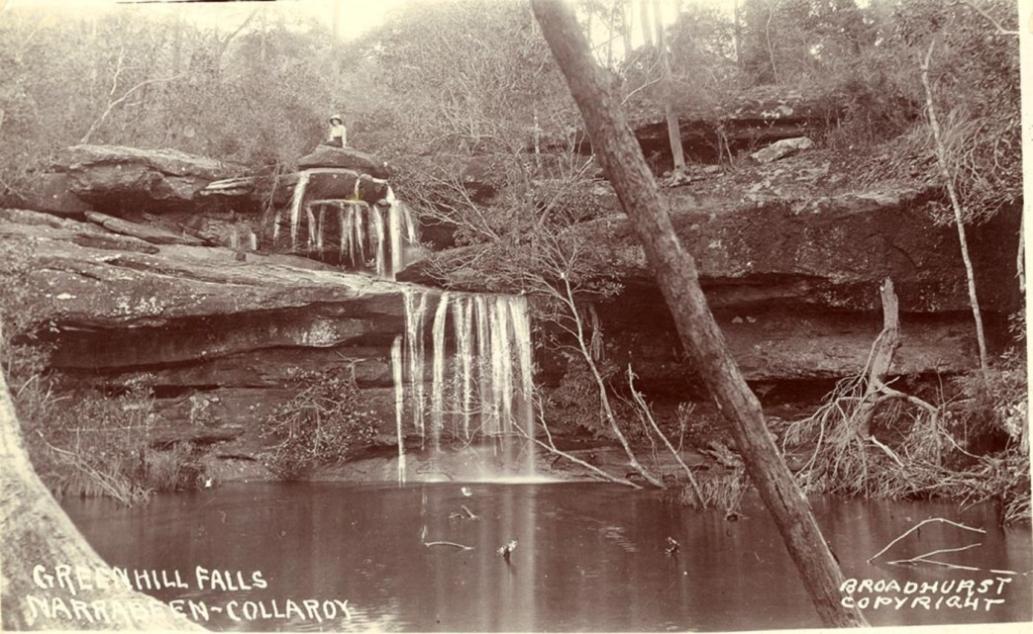
Greenhill Falls, Narrabeen-Collaroy, Image No.: a106059, from Album, Scenes of Narrabeen, N.S.W., ca. 1900-1927 Sydney & Ashfield : Broadhurst Post Card Publishers, courtesy State Library of NSW.
'Greenhills Estate' was up what we now call Powderworks road and comprised parts of the 'green hills'of Ingleside over a few subdivisions that went on past this first version:
The first subdivision sale of the famous and much-sought-after Narrabeen land is at last announced. Many people who desire a seaside block have been waiting to see how the land at Narrabeen will sell," and in view of the success attained at Cronulla it Is generally believed that Narrabeen will quite hold Its own with any of the ocean beach subdivisions. Boxing Day has been chosen for the first sale, when Messrs. Raine and Home'will'submit the Greenhills Estate, a subdivision which contains elevated home sites with splendid ocean views. The survey has been completed, and plans are now In
course of preparation.
In the same district, Messrs. Hardie and Gorman will on New Year's Day submit the Kyles of Bute Estate at Bayview, Pittwater. It is called after one of the most picturesque spots In Scotland, and the owner, who Is a "Scot," says this land, more commonly known as Baker's Orchard, always reminds him of the famous watering-place in his native heath, and this accounts for the name. There is only the road between the land and the beach. REAL ESTATE. NOTES OF THE WEEK. (1911, November 18). The Sydney Morning Herald (NSW : 1842 - 1954), p. 13. Retrieved from http://nla.gov.au/nla.news-article15289911
Raine and Horne(in conjunction with Robey, Hanson and Strong) on Boxing Day on the Greenhills Estate, Narrabeen, sold 136 allotments, at prices ranging from 5 s to 38s per foot. Total sale £5042. LAND SALES. (1911, December 27). Evening News (Sydney, NSW : 1869 - 1931), p. 2. Retrieved from http://nla.gov.au/nla.news-article115288278
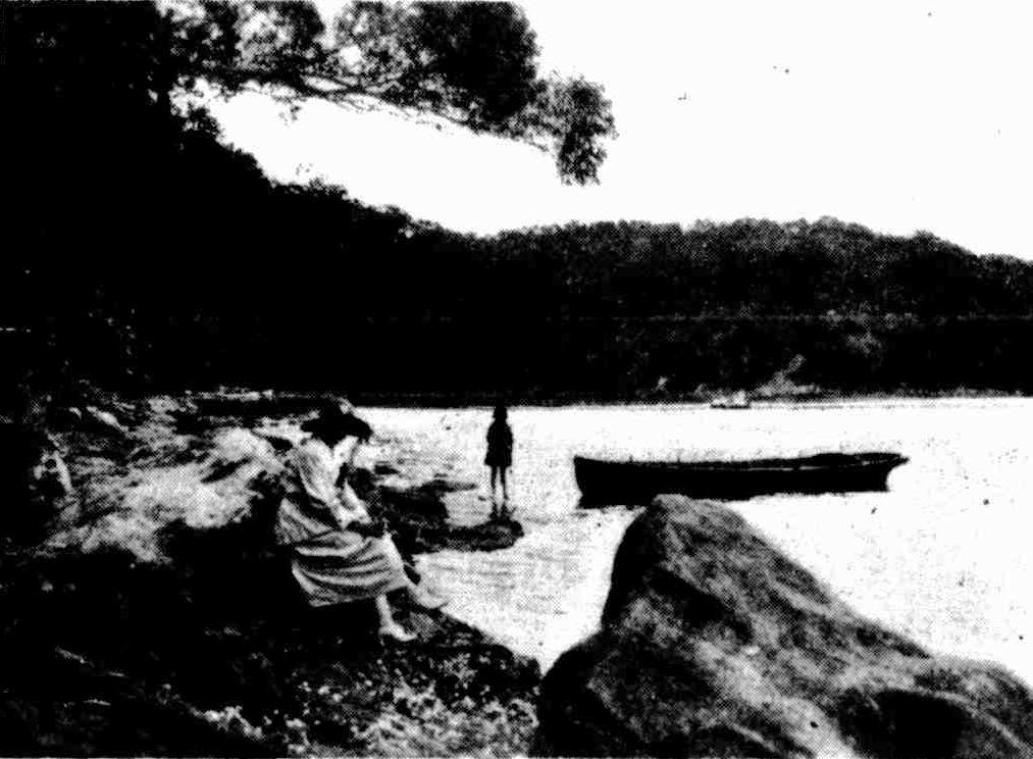
MIDDLE CREEK NARRABEEN LAKE. KNITTING WINTER DRESSES (1922, March 22). Sydney Mail (NSW : 1912 - 1938), , p. 23. Retrieved from http://nla.gov.au/nla.news-article169770043
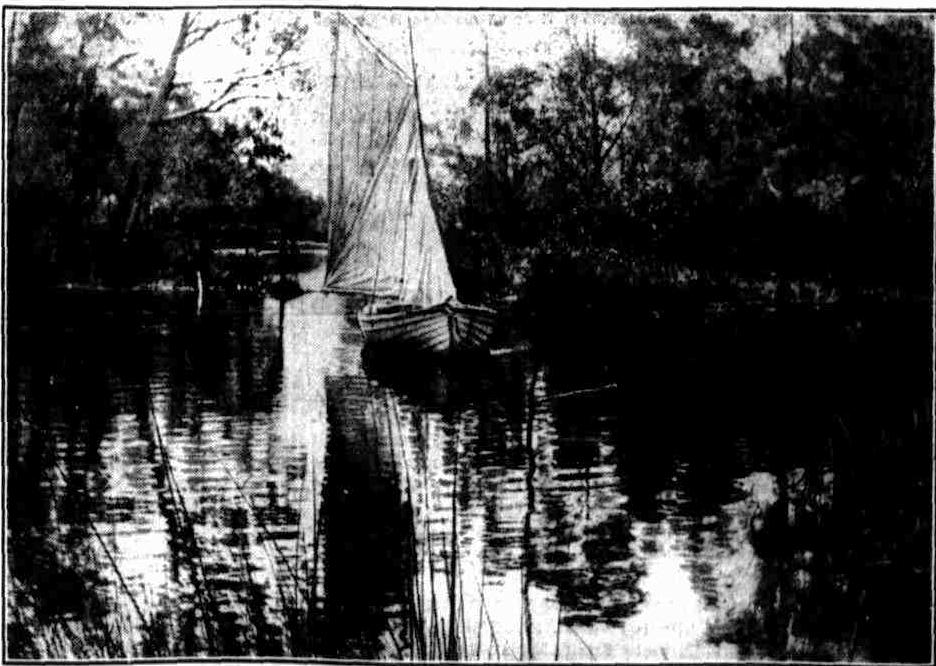
IN A SUBURBAN BACKWATER
This charming waterscape is within about an hours trip from Sydney. It is an arm of South Creek, which branches off Narrabeen Lake. Note the shadow on the Water. IN A SUBURBAN BACKWATER (1923, July 1).The Sun (Sydney, NSW : 1910 - 1954), , p. 13. Retrieved from http://nla.gov.au/nla.news-article224103931
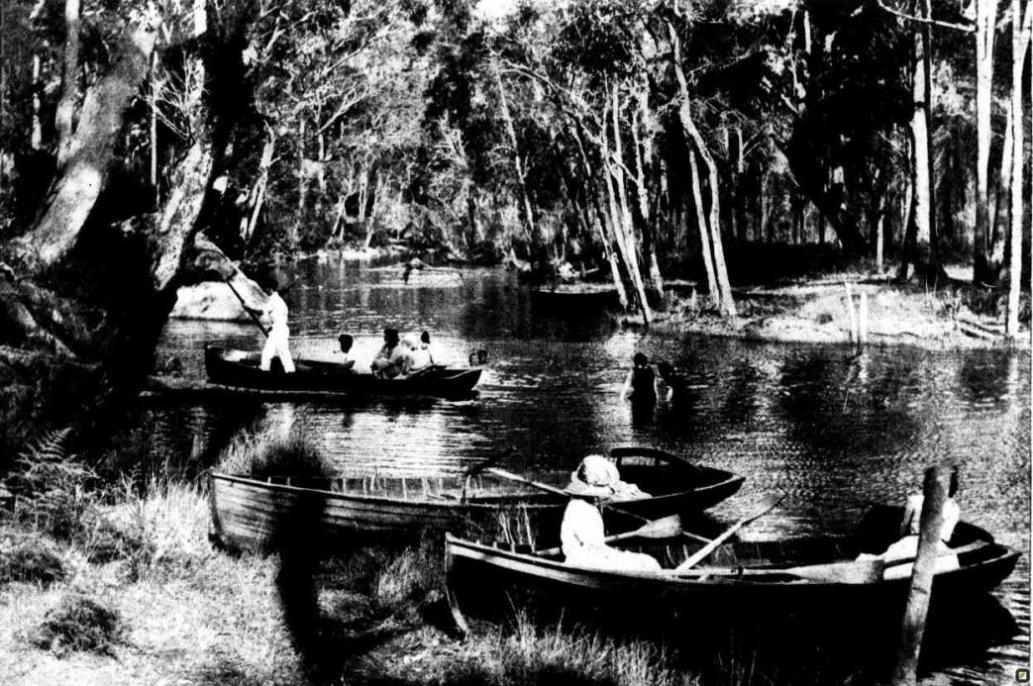
A BEAUTIFUL CREEK LEADING INTO NARRABEEN LAKE, A FEW MILES FROM MANLY. A BEAUTIFUL CREEK LEADING INTO NARRABEEN LAKE, A FEW MILES FROM MANLY. (1923, November 14). Sydney Mail (NSW : 1912 - 1938), , p. 11. Retrieved fromhttp://nla.gov.au/nla.news-article159035253
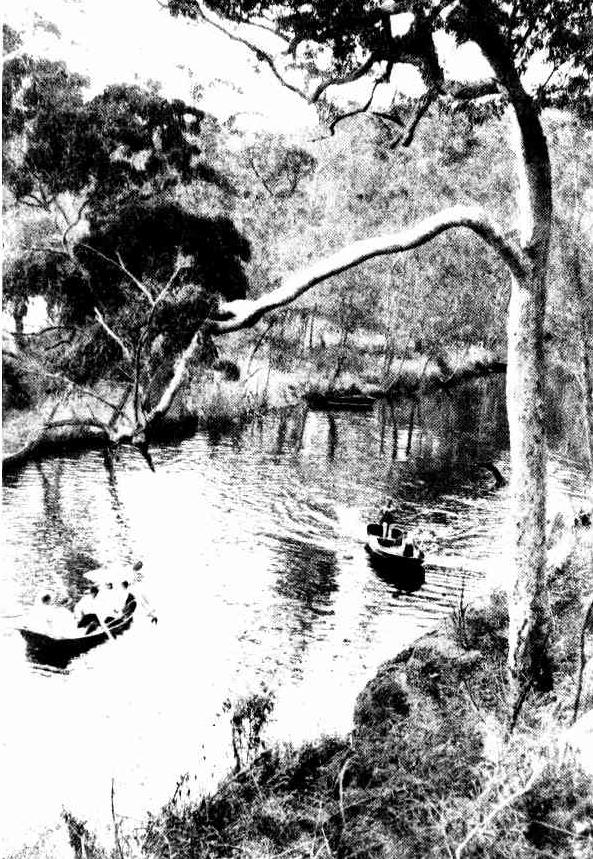
ON DEEP CREEK, NARRABEEN LAKE, A delightful spot between Manly and Newport, N.S.W. No title (1924, October 22). Sydney Mail (NSW : 1912 - 1938), , p. 33. Retrieved from http://nla.gov.au/nla.news-article169147240
This has already run in Narrabeen Lagoon And Collaroy Beachfront: Storms And Flood Tides Of The Past, for readers who didn't see that page:
WHEN NARRABEEN LAKE RUSHED OUT TO SEA.
Last week we published a brief account of some sea tragedies connected with the 'letting out' of Narrabeen Lake. Here we illustrate the event that created so much interest among residents on the other side of Manly.
SOME day Narrabeen Lake will be transformed into permanent navigable waters from the sea to the head of the three beautiful creeks five miles above the bridge, at the present tram terminus. During periods of drought (writes L.A.S.), when very little water is running out to sea, the action of the waves builds up a wall of sand at the entrance. This backs up the water, and when heavy rain falls it is thrown over the low-lying land for miles surrounding the lagoon, to the joy of the small boy and the black swan, and to the dismay and discomfort of the week-ender. To the permanent resident who delights to see his beloved lake 'full' the mere suggestion of 'letting it out' is sacrilege; but when the butcher refuses to call, the baker who delivers his bread is clad in a bathing-suit, and the stove wood floats into the best bedroom, it is realised it is time to call upon the shire council to 'let her out.'
Within ten minutes of this decision everybody in Narrabeen knows of it.
WHEN the momentous decision was come to recently I was told by an old hand not to worry about the fish being thrown up on the beach this time, because their numbers had been sadly depleted, net fishermen during the last two months having 'dragged the bottom out of the lake.' And so it proved. The only fish secured wore half a dozen small silver bellies. The porpoises, sharks, etc., who were instinctively waiting outside for the feast, had this time 'grossly exaggerated their instinct.' and it is not to be wondered at that they quarrelled among themselves. They were probably eating one another. Now, if the lake had been let out say, during February, there would have been something doing in the fish line. There were plenty of fish in the lake then. Despite, the poor half-dozen 'silver-bellies' this time, one could tell tales of wonderful hauls of fish on previous occasions. The most memorable was about fourteen years ago.
IT is the professional fisherman's business to know where the fish are in the estuaries along our coast. They knew that there were plenty of fish in Narrabeen Lake, and when they heard it war, to be let out they came from Botany and La Perouse and Watson's Bay, per medium of a varied assortment, of vehicles. After waiting all night, the lake broke out and the fish went through the channel, representatives of all the species, and in enormous numbers. The buffeting about and the sudden transmersion from practically fresh to strong sea water was too much for many pampered lake fish, and they were (brown back on the bandy shore by the waves in a stunned rendition in tons. All sorts of implements were used in their capture, from table forks to garden forks; they were thrown into chaff-bags, carts, kit-bags, tin dishes, baskets, and colanders. It is stated that over 50 tons of fish were secured. A few years later, when the lake was again opened, not a professional fisherman appeared on the scene; some amateur fishermen waited for two days, but did not get even six 'silver-bellies.' The lake had been netted beforehand. Everyman to his job. The accompanying pictures show the appearance of the channel a few hours after a gang of corporation labourers bad dug a 'let-out' in the sand to give the water a start. The rapidity with which the increasing volume of water displaced the thousands of tons of sand gave some idea of the enormous shifting power of a rushing stream. At 2 o'clock the channel was four feet deep and about six feet wide; at 5 o'clock it was 10 feet deep and 50 yards wide. On a rough calculation over 2000 acre feet of water rushed through the channel in two hours.
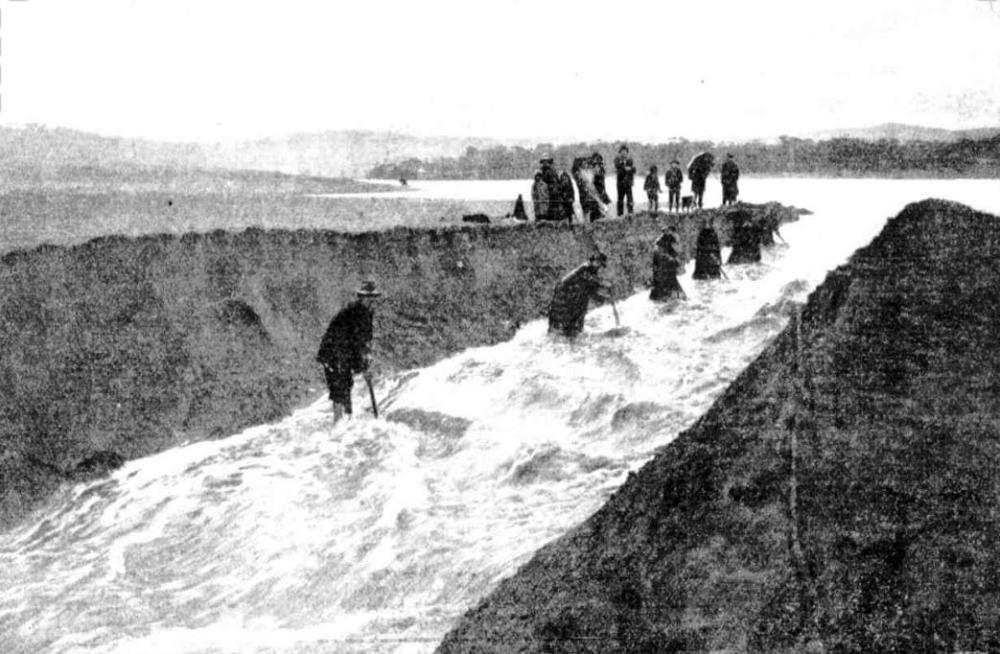
CUTTING THE CHANNEL THROUGH THE SANDBANK. A gang of men cut a narrow 'let out' about six feet wide— the water did the rest.
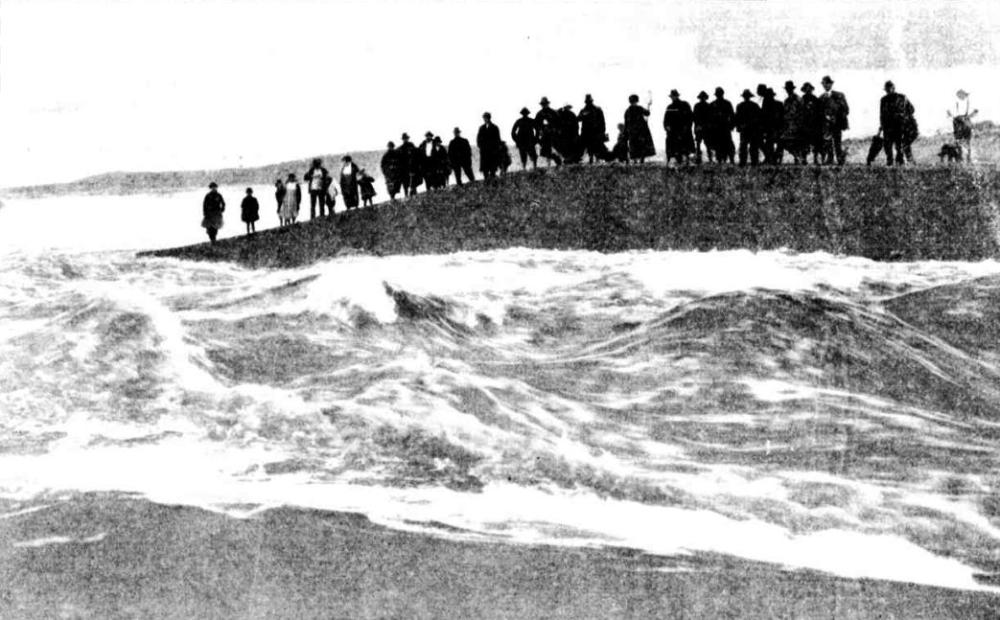
SOON AFTER THE OPENING OF THE CHANNEL. So great was the rush of water that within three hours the torrent was 150 feet wide. It is estimated that over 2000 acre-feet of water rushed out to sea in two hours.
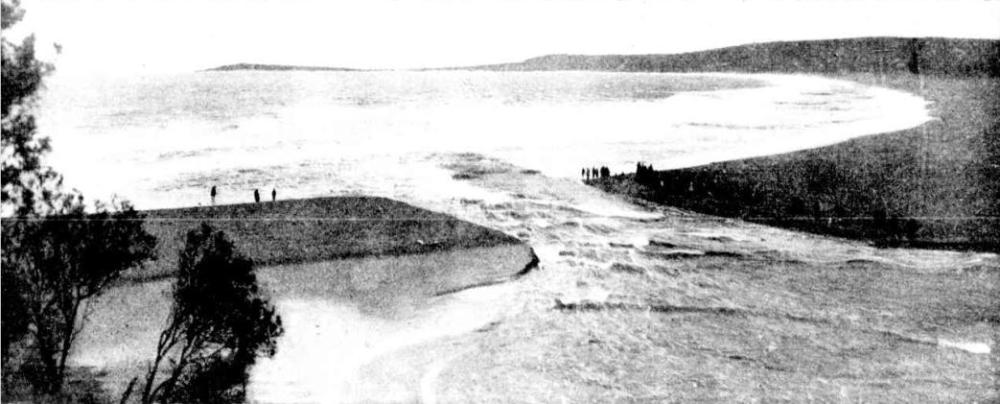
WHERE NARRABEEN AND THE SEA WERE JOINED JUST BEFORE THE LAKE RUSHED OUT.
WHEN NARRABEEN LAKE RUSHED OUT TO SEA. (1919, May 28). Sydney Mail (NSW : 1912 - 1938), , p. 13. Retrieved fromhttp://nla.gov.au/nla.news-article159655216
Of course what many of us know Narrabeen for is the wonderful walks beneath shady trees beside the waters and creeks - something this place has long been famous for and which, far from that space, will apparently still dispense balm like a pure spring straight from the heart of Spring from just one whiff:
GUMS FROM NARRABEEN.
"Gum tips," he sang outside the Quay,
And waved his bunch of green.
Before the hurrying passers by,
"Fresh gums from Narrabeen."
I bought them, and their magic touch
Transformed the busy scene.
The crowded streets were blotted out,
The blue morn walked, serene,
By range and road and purple lake,
And slopes of dewy sheen.
The first spring magic dwelt within
Those gums from Narrabeen.
NELLIE A. EVANS
GUMS FROM NARRABEEN. (1932, October 8). The Sydney Morning Herald (NSW : 1842 - 1954), p. 8. Retrieved from http://nla.gov.au/nla.news-article28033175
Extras:
NARRABEEN MEMORIAL UNVEILED.
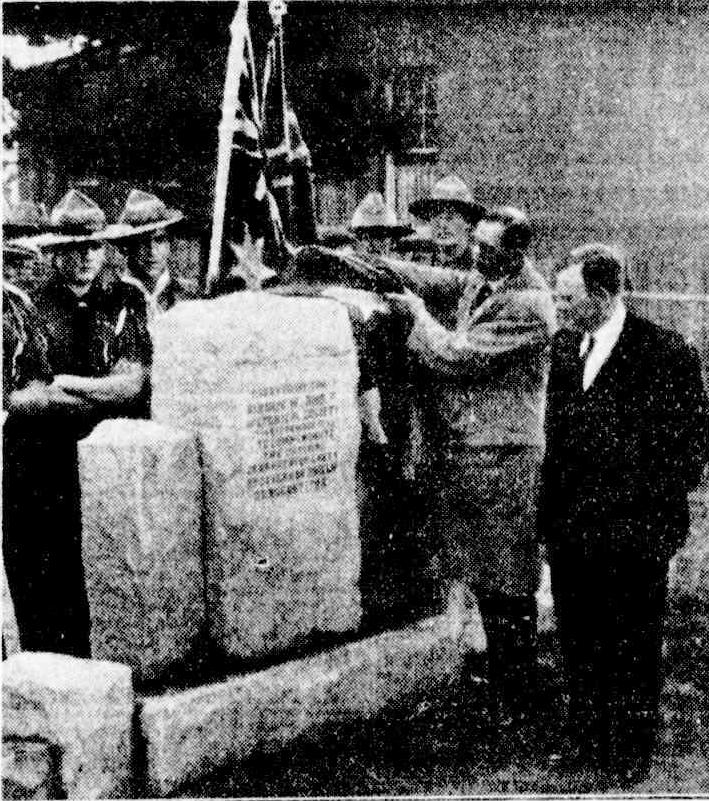
Mr. W. L. Ross unveiling the stone at the school commemorating Governor Phillip's discovery of Narrabeen Lakes in 1788. NARRABEEN MEMORIAL UNVEILED. (1932, September 19). The Sydney Morning Herald (NSW : 1842 - 1954), p. 12. Retrieved from http://nla.gov.au/nla.news-article16896695
NARRABEEN LAKES.
Governor Phillip's Crossing.
A stone monument to commemorate the first crossing of the Narrabeen Lakes by Governor Phillip on August 22, 1788, has been erected in the grounds of the Narrabeen School by Mr. James Booth, of Pittwater, and given by him to the Manly, Warringah and Pittwater Historical Society.
The unveiling ceremony was performed on Saturday by Mr. W L Ross headmaster of the school and a vice-president of the society. Mr. A G Priddle, chairman of the Narrabeen Parents and Citizens' Association presided at the outset, being followed by Captain M J Lowe, president of the Historical Society. Among the speakers were Councillor Shepherd, president of the Warringah Shire Council and Mr. P W Gledhill, secretary of the society.
Lieutenant-Commander Salter, RN, formerly of H M A S Sydney broke a flag which is a replica of the Union flag flown by Governor Phillip on the shores of Sydney Cove in 1788. NARRABEEN LAKES. (1932, September 19). The Sydney Morning Herald (NSW : 1842 - 1954), p. 6. from http://nla.gov.au/nla.news-article16896701
THE BRIDGE AT NARRABEEN.
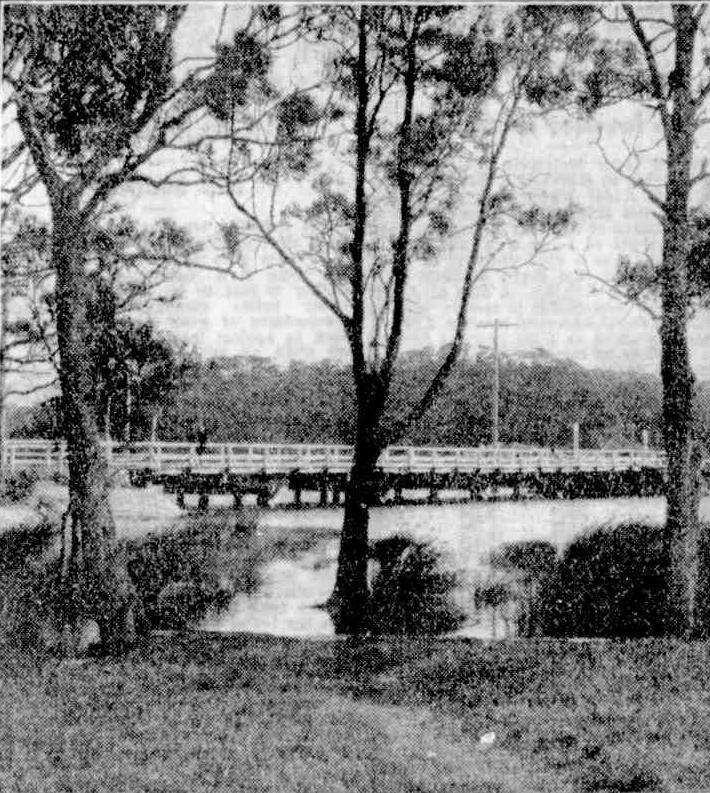
A glimpse through the trees towards the bridge at Narrabeen. THE BRIDGE AT NARRABEEN. (1933, July 22). The Sydney Morning Herald (NSW : 1842 - 1954), p. 16. Retrieved from http://nla.gov.au/nla.news-article16993223
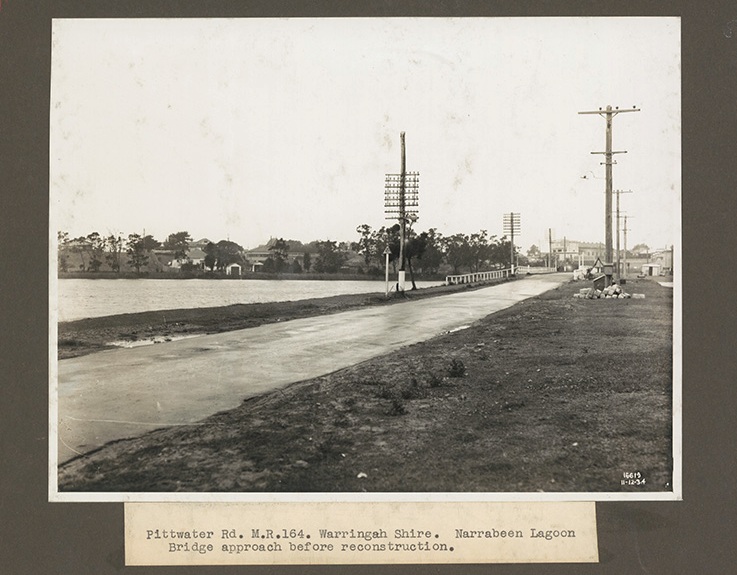
From NSW State Records - dated 1934
Manly's Australian Life Biograph Company
The Australian Life Biograph Company was a short lived Australian film production company in the silent era. It funded many of the early films of Gaston Mervale and Louise Lovely. The company was formed in 1911 with capital of ₤6,000 and was based in Sydney. It produced eight feature films in total, all directed by Mervale, who used a stock company of actors including Lovely (then known as Louise Carbasse), Jerome Partick, Godfrey Cass and Harry Beaumont. Movies were shot at Biograph's glass-roofed studio in Manly, New South Wales.
In the words of film historians Graham Shirley and Brian Adams "the subjects chosen were predominantly colonial, with no less than six featuring prison themes, usually with an innocent man receiving a pardon or making his escape." Most of them also had a strongly Australian flavour.
At one stage the company was earning over ₤300 a week and employing six lecturers to accompany the films. However they had trouble finding a market for their work and the company later wound up and merged into Universal Films Ltd in 1912.
Gaston Mervale (1882–1934) was an Australian director and actor who worked extensively on stage and in films. He directed several films for the Australian Life Biograph Company. After this wound up he went to New York and worked as an actor for several years. He returned to Australia in 1917 to produce plays.
Filmography
• One Hundred Years Ago (1911)
• A Ticket in Tatts (1911)
• The Colleen Bawn (1911)
• A Tale of the Australian Bush (1911)
• Hands Across the Sea (1912)
• A Daughter of Australia (1912)
• Conn, the Shaughraun (1912)
• The Ticket of Leave Man (1912)
A Tale of the Australian Bush
A Tale of the Australian Bush is a 1911 Australian silent film directed by Gaston Mervale. It was also known as Ben Hall, the Notorious Bushranger and is considered a lost film. The story of the bushranger Ben Hall, including his duel with Melville, last stand and death. A contemporary review said that "unlike the usual bushranging films, instead of glorifying the villainy of the criminals of the bush, recorded a triumph of the law over the lawless."[3]
Cast; A.J. Patrick as Ben Hall, Godfrey Cassas Melville, Harry Beaumont as Gilbert, James Martin as Keightley, Gilbert Emery as chief of police,Harrie Ireland as Mrs Keightley, Isma Owe and Robbie Hall, Louise Carbasse as Mrs Hall.
It was the first film from the production company Australian Life Biograph Company
One Hundred Years Ago
One Hundred Years Ago is a 1911 Australian silent film directed by Gaston Mervale. It features an early screen performance from Louise Lovely (billed as "Louise Carbasse") and is considered a lost film. The movie was billed as "an Anglo-Australian romantic drama". Jasper Hugh Lovel is sent to prison at Norfolk Island for a crime he did not commit. A woman in England who loves him manages to secure his pardon and they are reunited.
Cast; Louise Carbasse as Judith (in love with Lovel), Harrie Ireland as Katharine (a burglar's wife), A.J. Patrick as Lovel (a young squire), Godfrey Cass as Captain Ridd (his rival), Alf Scarlett as an Old Jew (a receiver of stolen goods), James Martin as a magistrate, Harry Beaumont as a Burglar, Harry Carew as The Governor, Tom Lucas as a Young Man
The film was shot at Australian Life Biograph's factory in Manly, New South Wales.[4] Unlike many Australian films of the time, it was an original script, not based on a play. The author was Patrick William Marony. The story is founded on fact. In an old cell at Norfolk Island may be seen the following inscription: "I, Jasper Hugh Lovel, here proclaim, before God and man, I am innocent. May God avenge me on mine enemy." fromWikipedia
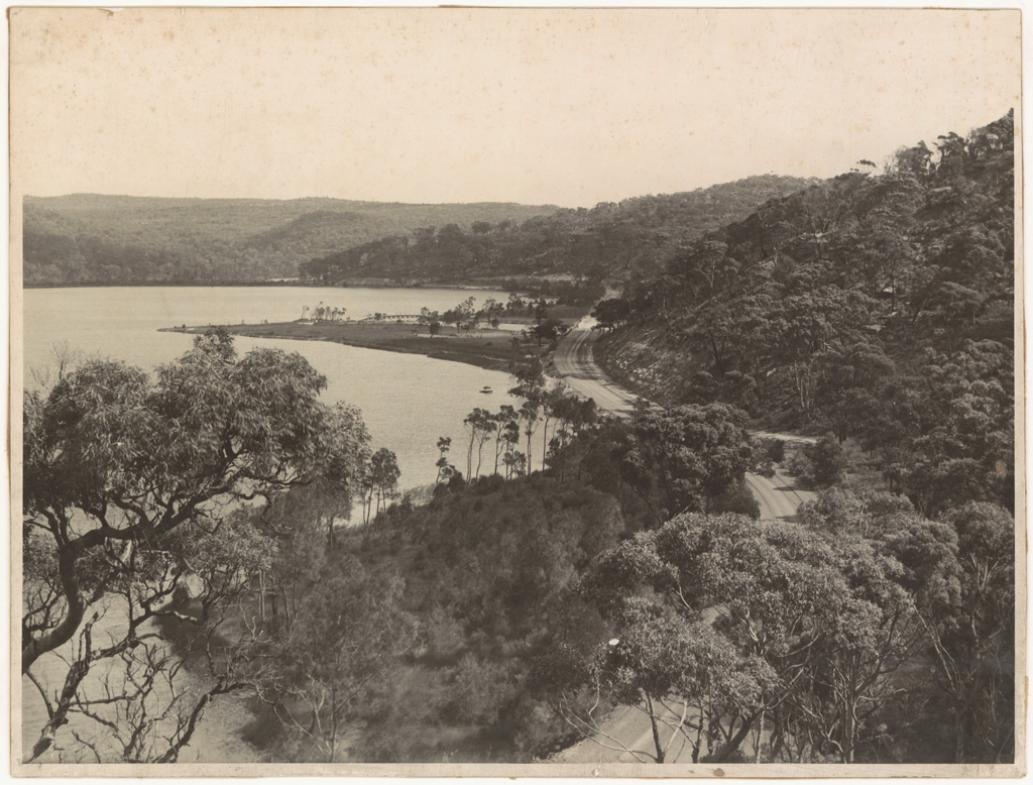
'Narrabeen lake 1946 looking west' - Image Courtesy NSW State Records, Image No.: 20224_a038_001761
Narrabeen Spring Celebrations 2016: A Few Glimpses Into Narrabeen's Past Beauties - threads collected and collated by A J Guesdon, 2016.